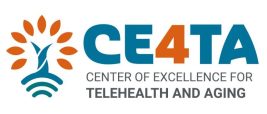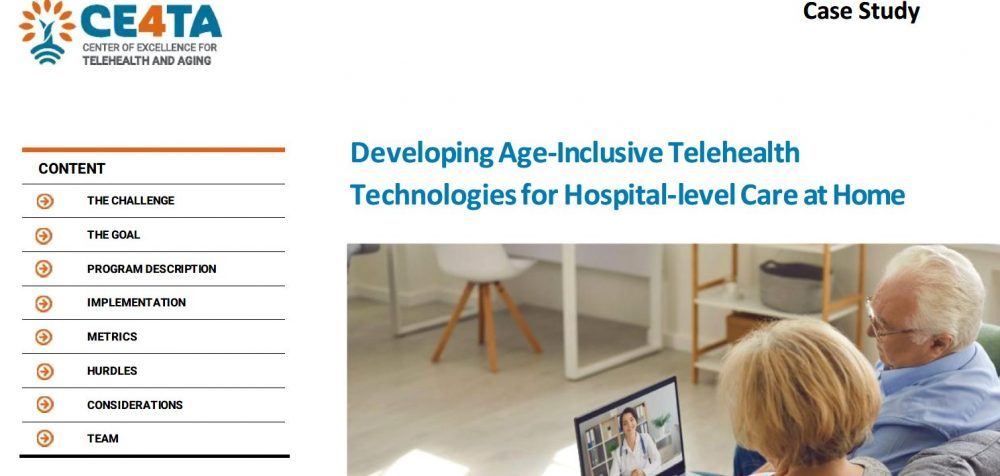Produced by West Health
October 26, 2023
Designing and curating the right suite of devices and technologies to deliver high-level acute care in the home can be a challenge for both older patients and providers. Older adults, who often present with complex medical conditions, are sometimes thought of as being the last to adopt new technological advances. In the case of telehealth and hospital level care at home, however, older adults were the early adopters and are advancing the movement for high-acuity care at home. Simple, effective, and integrated technology solutions are needed for patients who prefer to be treated at home.
Medically Home developed a healthcare delivery model that includes a technology platform to seamlessly provide hospital-level care to patients in their homes. Medically Home provides health systems with care model, technology, logistics, and tools to safely care for patients with serious, complex, or high-risk illness. They create a temporary hospital room in a patient’s home by installing a system for a hybrid of virtual and in-person care that easily connects to care teams 24 hours a day. Their aim—meet the needs of both patients and healthcare providers. “We wanted to create a platform that the patients would be able to use easily,” said Linda V. DeCherrie, MD, Vice President-Clinical Strategy and Implementation at Medically Home. “For the provider side, the platform needed to be something they could easily access to conduct their video visits, see the patient’s vital signs and gather all the necessary information.”
Medically Home is currently in operation with healthcare systems in 17 states and has served more than 24,000 patients since its inception in 2015. With the average patient age of 68 (men) and 69 (women) it was important that a system be designed to be approachable for all ages and abilities. “We really needed patients to not be intimidated and to feel like [the technology] was useful to them so they could communicate with their nurse or physician in a way that felt really comfortable,” said Pippa Shulman, DO, MPH, chief medical officer at Medically Home. “We also needed to make sure the clinical team knew that we were safely monitoring and caring for patients.”
Medically Home joined the Collaborative for Telehealth and Aging (lead by West Health Institute, University of Virginia Department of Geriatrics, and the Mid-Atlantic Telehealth Resource Center) in 2021 to help develop principles and guidelines to advance age-inclusive telehealth. These principles highlight the importance of ensuring telehealth is person-centered, equitable and accessible, and integrated and coordinated. They have continuously improved their care model and technology to ensure these principles are put into practice. In doing so, Medically Home has designed a technology solution that delivers home-based acute care that is high-quality, simple, and effective.
Building a System with Equity, Person-Centeredness, and Integration in Mind
Medically Home’s care model incorporates several strategies and capabilities to provide a virtual and in person system of care that is accessible, reliable, and safe. Both DeCherrie and Shulman said the components of the in-home technology suite were assembled to meet three criteria: patient safety, redundancy, and ease of use for the widest group of patients.
“Many [other] devices are created for use in a hospital or a very specific situation but that doesn’t work for a patient in their home. There was a need for a balance of what was clinically useful — what gives us the information we need to take clinical action for the patient without covering the patient with stickies and intermittent devices and making it really complicated,” Shulman said. The team went through many rounds of iteration during the early stages of Medically Home’s development.
To address connectivity and ensure equipment compatibility, Medically Home provides internet connectivity, and brings a group of devices to every home. The devices include: a dedicated tablet; a dedicated phone; an uninterruptible power supply; a Personal Emergency Response System (PERS) bracelet or pendant; a Bluetooth-enabled scale and biometric monitoring devices; and Cradlepoint, which provides backup internet connectivity and is equipped with chips for the two dominant cellular carriers in the area. To meet the needs of visually impaired patients, the tablet interface was designed with a large font and a color scheme tailored to visual impairments, as well as accessible buttons with large targets to quickly connect the patient to their care team. Patient education materials are included on the tablet.
The care model promotes integration and coordination in a few different ways. During the initial visit, the clinician works with the patient to ensure devices have seamless connectivity, are integrated with each other, that the physical locations of the devices are in highly frequented and accessible areas, and don’t pose a fall risk. Additionally, it facilitates bi-directional communication between the care team, patients, and in-home service providers and promotes data integration with electronic heath records. To do this, the company uses a software platform called Cesia that also supports logistics management for the home hospital visit.
Medically Home also prioritizes stakeholder feedback and observational data to develop and improve products and services. One example of continuous improvement was the phone provided to patients. The original version required the patient to dial their care team. However, patients didn’t like that feature — the buttons were small and not easily read. – Now, the dedicated phone in use provides a direct connection to the command center — no dialing necessary. Another example was simplifying the installation process for when a patient was admitted to the home hospital service. Many older patients found the process to be overwhelming with too many people involved. To overcome this challenge, a training program was developed to teach the clinician making the admissions visit — in most cases a paramedic — how to set up the technology as well as train patients on the devices. This created greater efficiency of the installation process and less disruption for the patient.
Their strategies facilitate access to health information, connect crucial stakeholders, account for technology literacy and readiness, and use telehealth to increase access to acute care. All of those components are pillar ideals highlighted in the Principles and Guidelines for Telehealth and Aging.
Looking Ahead
Medically Home wants to continue improving the efficiency of the care model to be able to provide this service to more people. “Our goal is to build a scalable program for a health system that is equivalent — or more — to a unit of their hospital. We want to be able to care not for just two or three patients, but 15, 20, 30, 40, 50 patients,” said Shulman.
They also want to ensure their model and technologies maintain high satisfaction among patients and providers, as well as continue to demonstrate improved patient outcomes. Of the patients admitted to Medically Home programs, 95% have said they would recommend it to others. The mortality rate for Medically Home program patients was reduced by 50% with all cause readmissions rate of 7.6% between January and November of 2021. Implementing a new virtual care model that is person-centered and integrated is challenging work for both Medically Home and the partnered healthcare system. But it’s necessary work to ensure telehealth can continue to be an effective healthcare option for all patients.
Pledge of Support for Age-Inclusive Telehealth Practices
Medically Home demonstrated their commitment to providing and advocating for age-inclusive telehealth services by signing the Pledge of Support for Age-Inclusive Telehealth Practices. If your organization is also committed to providing high value telehealth care for older adults, visit The Center of Excellence for Telehealth and Aging and sign the pledge. Also, visit the Center of Excellence to learn more about the Principles and Guidelines for Telehealth and Aging.

